Typology 1: Cornerstone Institutions
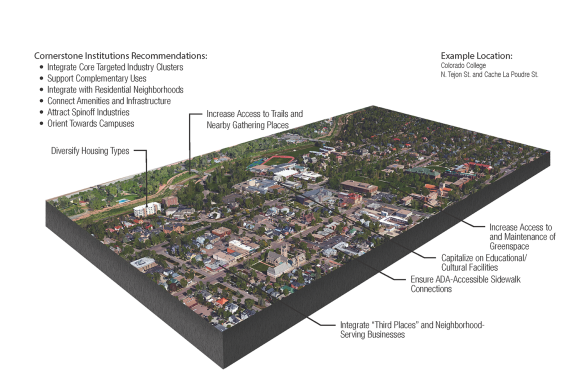
The goal of this typology is to support, reinforce, and expand these cornerstone institutions and to connect and integrate them within the larger community.
Core educational, medical, aviation, and military institutions of Colorado Springs have long served as the foundation of the local economy. The economic success of the city is in large part driven by these institutions. They attract and create new talent, generate emerging spinoff industries, and enhance overall quality of life in Colorado Springs. While these institutions are located throughout the city, they are most often concentrated on major campuses that function as nodes of activity and employment. Ensuring these institutions remain strengths for Colorado Springs while also integrating into surrounding neighborhoods is a focus of this Plan. This can be accomplished through continued investment in quality infrastructure, integrating these campuses within surrounding neighborhoods, and collaborative approaches to meet workforce needs such as nearby attainably-priced housing. Places that accommodate this industry typology include Downtown, other urban activity centers, and existing and new campus-style developments.
- Examples: UC Health-Memorial Health System, Penrose-Saint Francis Keys College, University of Colorado-Colorado Springs, Pikes Peak Community College, U.S. Air Force Academy, Peterson Air Force Base, Fort Carson, and the Colorado Springs Airport.
Typology 2: Spinoffs and Startups
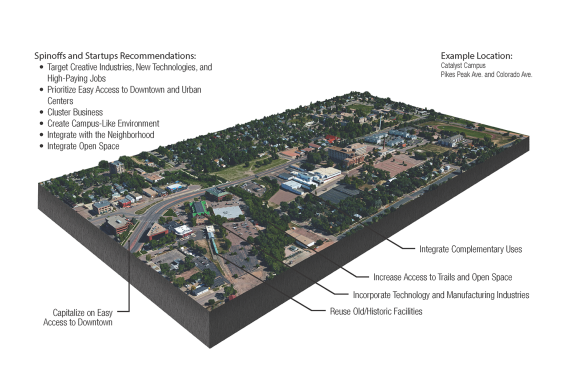
The goal of this typology is to become increasingly competitive at business and worker attraction in medium and high-wage jobs by supporting the creation of environments that attract them and allow them to thrive.
Spinoff and startup industries are those that are emerging as increasingly important segments of the local economy and jobs base. These include technology, cybersecurity, green industries, sports-based industries, and creative industries. This typology also includes two of the Chamber’s targeted industry clusters: sports medicine and related health services, and professional, scientific, and technical services.
Based on national economic trends, the importance of these emerging industries is only expected to grow, particularly those based in technology. While some segments may not yet be well represented locally, they all appear to be a strong fit with Colorado Springs’ unique economic assets, location, and workforce. The City can help nurture these industries through strategic alignment of incentive programs, workforce initiatives, enhanced infrastructural amenities such as high-speed fiber, and encouragement of compact, walkable districts with urban amenities.
Places that are optimal for this typology include Downtown, mixed use neighborhood activity centers, and districts that enable an eclectic mix of commercial and industrial uses, such as office parks, Innovation Districts, employment corridors such as Garden of the Gods Road, and mixed business districts such as the area south of Citadel Mall.
- Examples: Catalyst Campus, Epicentral Co-working, and The Enclave.
Typology 3: The Experience Economy
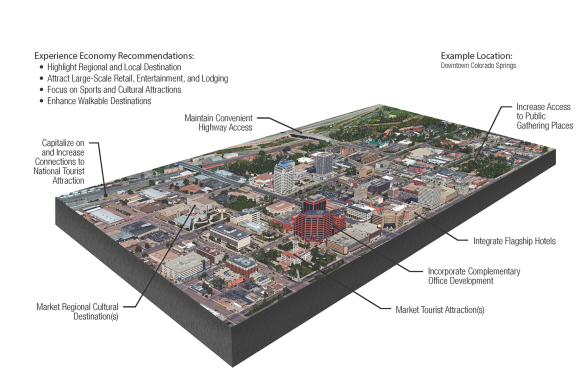
The goal of this typology is to support a variety of high quality existing and new attractions and related amenities for residents and visitors, appealing to a diverse mix of interests and incomes.
The experience economy includes tourism, entertainment, and cultural industries throughout the region that serve both residents and visitors. This typology has a particularly high correlation with the Cultural and Tourist Attractions in Chapter 6. This sector can be a catalyst for economic growth across the spectrum of other typologies by encouraging spending in areas impacting sales tax collections. The experience economy is critical to maintaining high quality of life, a factor that is important for attracting and retaining skilled talent and the businesses that rely on these workers. The strategies that relate to this typology focus on enhancing infrastructure, transportation, connectivity near venues, and activating areas targeted for new entertainment amenities. Places that are optimal for this typology include Downtown, areas on and adjacent to Colorado College’s campus, Old Colorado City, and places associated with our parks and other civic spaces.
- Examples: The U.S. Olympic Museum and Colorado Springs Olympic Training Center, Pioneers Museum, The Fine Arts Center, The Money Museum, Pikes Peak Center for the Performing Arts, Cottonwood Center for the Arts, ENT Center for the Performing Arts at University of Colorado-Colorado Springs, Garden of the Gods, Manitou Incline, the Olympic Velodrome, and resort and convention destinations such as the Broadmoor, Cheyenne Mountain Resort, and Great Wolf Lodge.
Typology 4: Life and Style
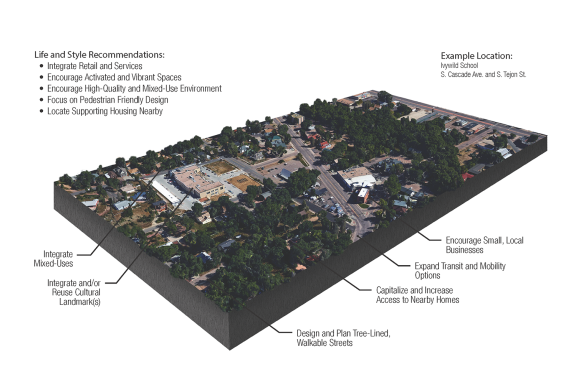
The goal of this typology is to meet the daily needs of residents and businesses with high quality, varied, and easily accessible options.
The Life and Style typology encompasses much of the large retail and services sector that serves the daily needs of local residents and businesses. It is important that this typology is dispersed throughout Colorado Springs and easily accessible to all. Places that accommodate this typology include corridors, neighborhood centers, community activity centers, entertainment and commercial centers, along with places within regional activity centers and Downtown (as defined in Chapter 3: Unique Places). Strategies in support of this typology promote neighborhoods and encourage activation of Downtown and numerous other connected and accessible retail and service districts.
- Examples: Large retail and service destinations such as First and Main Town Center and Citadel Mall, community shopping centers, small neighborhood centers, and stand-alone retail, restaurant, and service establishments.
Typology 5: Industry Icons
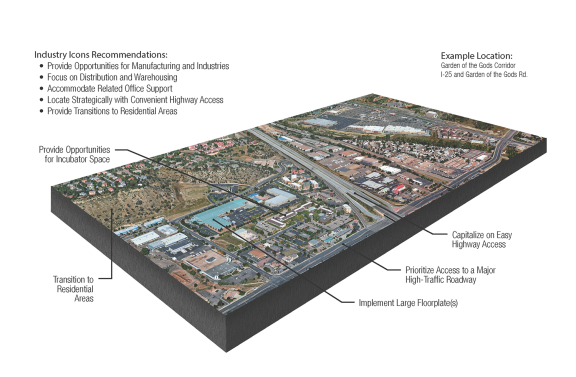
The goal of this typology is to maintain and grow a diversified primary employment and manufacturing economy that attracts investment and provides a variety of jobs and opportunities for the local workforce.
The manufacturing, distribution, data processing and national service industries are a traditional strength of the Colorado Springs economy. This segment of the economy is diverse and provides varied employment opportunities. It builds upon the city’s established strengths in semiconductor and related device manufacturing, aerospace and defense, as well as newer strengths such as datacenter operations. Some of its businesses fall within one of the Chamber’s three target clusters: aviation and specialty manufacturing.
Places that are optimal for this typology include highway and major road corridors, near the airport, and along railroad corridors, areas that fit its specific infrastructural needs. To continue and strengthen this industry, enhanced infrastructure and coordination with community colleges and workforce training programs are needed, as well as protecting the limited number of key sites that are desirable to large new employers of this typology.
- Examples: Bal Seal Engineering, Microchip Technologies, Advantage Manufacturing, Springs Fabrication, Ace Hardware Distribution Center, Northrup Grumman Warehouse, USAA Insurance, and Walmart Colorado Data Center.
Typology 6: Critical Support
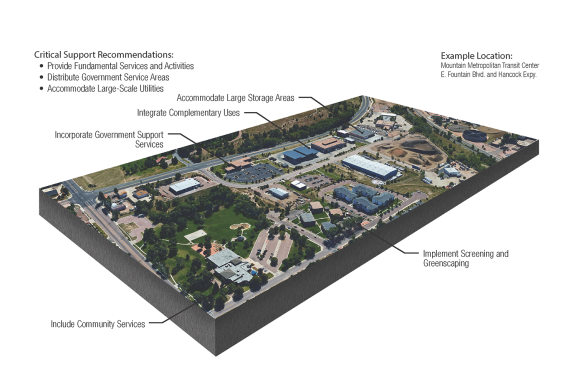
The goal of this typology is to ensure fundamental needs of residents and businesses are reliably met every day.
There are fundamental activities that ensure that the city continues to work on a day-to-day basis including reliable utility services, keeping it clean and safe, removing waste, constructing buildings and infrastructure, growing and production of local foods, and responding to emergencies. A majority of this work takes place behind the scenes, but is critical to a functional and livable city.
Places that can accommodate this economic typology are those along interstate and highway corridors that are properly buffered from residential areas. These areas require truck, heavy equipment, and sometimes rail access. Some industries in this typology are a fit in locations that would be suitable for the Industry Icons typology. Others have a combination of requirements and impacts that support their segregation from most other uses in the city. Strategies to support this typology focus on maintaining quality basic infrastructure, identifying and retaining sites and locations for higher impact industrial-type uses, reducing impact on nearby residential areas, providing affordable workforce housing, and fiscally responsible city management to ensure that Colorado Springs’ city services remain reliable.
- Examples: El Paso County Citizens’ Service Center, Colorado Springs Utilities, waste haulers, construction companies, and outdoor storage facilities.
